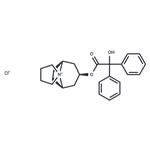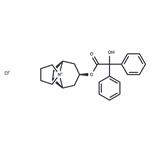Trospium chloride (Sanctura) is an antimuscarinic that has been used in Europe for the management of OAB symptoms for over 30 years.Trospium chloride's chemical structure is such that it is unlikely to penetrate the brain and thus does not appear to affect cognitive function. Trospium chloride is usually administered orally twice a day in 20mg. Trospium chloride should be taken 1 hour before meals or on an empty stomach. It is not well absorbed if taken with food.An advantage of this medication is that it has little potential interaction with other medications.
White to Off-White Crystalline Solid
Labeled Trospium, intended for use as an internal standard for the quantification of Trospium by GC- or LC-mass spectrometry.
An antimuscarinic compound that inhibits mAChR M
Tropine derivative with anticholinergic activity, Trospium chloride can be used as Antispasmodic and used in treatment of urinary incontinence
ChEBI: Trospium chloride is an organic chloride salt of trospium. It is an antispasmodic drug used for the treatment of overactive bladder. It has a role as a muscarinic antagonist and an antispasmodic drug. It is an organic chloride salt and a quaternary ammonium salt. It contains a trospium.
12.7 g of nortropine and 21.6 g 1,4-dibrombutane are heated, with stirring,for 14 hours at 38-40°C in 200 ml 70% ethanol in the presence of a strongly
basic ion exchanger. The reaction mixture is filtered, the filtrate brought to a
pH of 4-5 by addition of dilute hydrochloric acid, then evaporated to dryness
in a vacuum. The residue crystallized from ethanol-ether. Azoniaspiro-(3α-
hydroxy-nortropan-8,1'-pyrrolidine) chloride is obtained in a yield of about
51%; melting point 294-297°C.
2.17 g azoniaspiro-(3α-hydroxy-nortropan-8,1'-pyrrolidine) chloride and 4.24
g acetyl mandelic acid chloride are heated in a vacuum (12 mm Hg) for 6n
hours at 100°C. After the addition of 40 ml water, the reaction mixture is
repeatedly extracted, the aqueous phase adjusted to pH 6.7-6.8 and
continuously extracted with chloroform for 24 hours. After the addition of 20
ml concentrated hydrochloric acid, the residue of the chloroform extract is left
to stand for 15 hours at room temperature. The hydrochloric acid is then
removed in a vacuum, the residue taken up in absolute ethanol, filtered
through aluminum oxide. The filtrate evaporated to dryness and the residue
crystallized from methanol-acetone. Azoniaspiro(3α-benziloyloxy-nortropan-
8,1'-pyrrolidine)-chloride is obtained in a yield of about 20%; melting point
197-198°C.
Anticholinergic, Spasmolytic
Trospium chloride, 3α-benziloyloxynortropane-8-spiro-1'-pyrrolidinium chloride, (Sanctura) was available in Europe for almost 20 years before gainingapproval in the United States in May 2004. Much likeoxybutynin, it too is a competitive antagonist for muscarinicreceptors and is used to manage overactive bladder. Thequaternary amine reduces the likelihood that this agent willcross the blood-brain barrier. In addition, it has a limitedmetabolic profile, largely a result of its highly water-solublecharacteristics.
Antimuscarinic:
Symptomatic treatment of urinary incontinence, frequency or urgency
Potentially hazardous interactions with other drugs
Anti-arrhythmics: increased risk of antimuscarinic
side effects with disopyramide.
The metabolic pathway of trospium in humans has not
been fully defined. Of the 10
% of the dose absorbed,
metabolites account for approximately 40
% of the
excreted dose following oral administration. The major
metabolic pathway is hypothesised as ester hydrolysis
with subsequent conjugation of benzylic acid to form
azoniaspironortropanol with glucuronic acid.
The mean renal clearance for trospium (29 L/hour) is
4-fold higher than average glomerular filtration rate,
indicating that active tubular secretion is a major route of
elimination for trospium. There may be competition for
elimination with other compounds that are also renally
eliminated.



